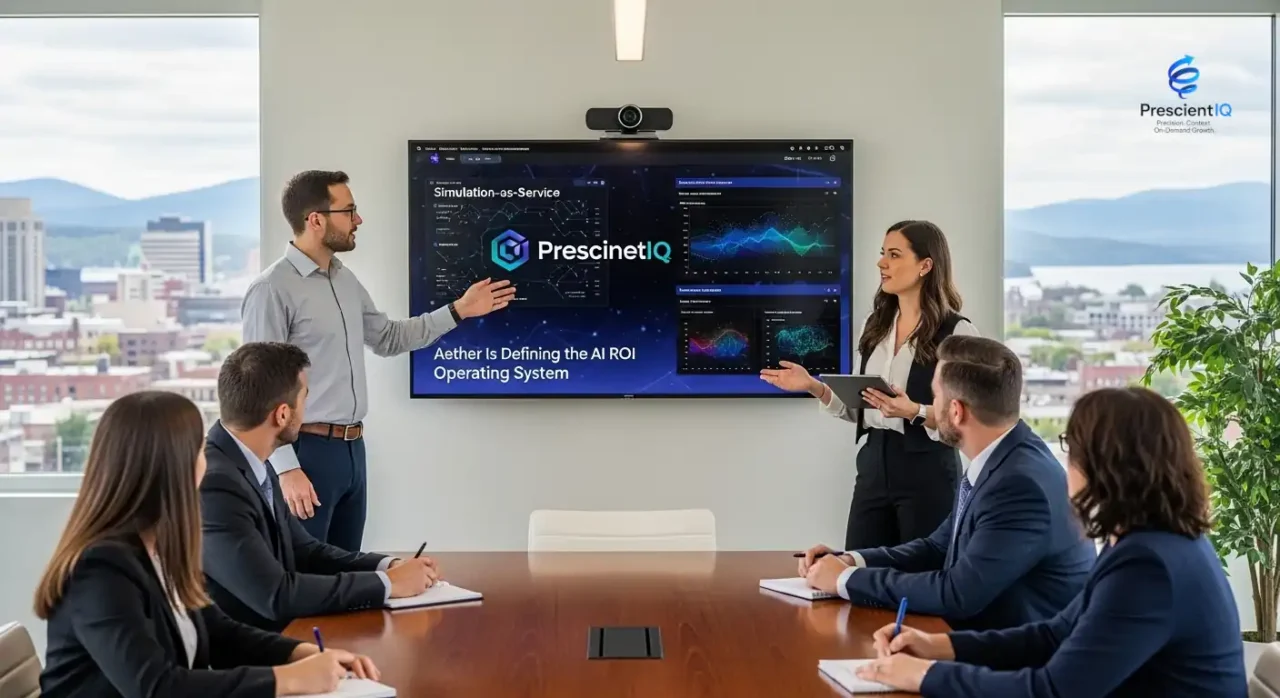How to Measure Non-Branded Click-Through Rate (CTR)
Learn How to Measure Non-Branded Click-Through Rate (CTR)
When No One Knows Your Name: Mastering the Art of Non-Branded Click-Through Rates
In the bustling digital marketplace, where countless brands jostle for attention, there’s an unspoken challenge: how do you capture interest when your name isn’t yet on everyone’s lips?
For marketing managers striving to make an impact, understanding how to measure non-branded click-through rate (CTR) is crucial. Your content must work harder to earn the click when no one knows your name.
Imagine walking through a crowded street market, where each stallholder vies for your attention. Some rely on the power of their brand, and their names alone draw in curious customers. But what about those who are new, whose names are yet to resonate?
Decision Journey Explorer
Explore the 4S behaviors—Streaming, Scrolling, Searching, and Shopping—with adaptive contrast and an accessible diagram.
Flow & Influence Map — Technical Validation Bias
Streaming Awareness → Authority
Webinars, product demos, and podcasts that showcase applied AI/data outcomes.
Industry briefings, analyst interviews, and case videos to build credibility.
Recommended tactics
- Anchor series (monthly) + on-demand library
- Repurpose to shorts/snippets for social amplification
- Contextual CTAs to “Try the sandbox” or “Book a demo”
Scrolling Discovery → Recall
Short-form posts, infographics, and employee advocacy highlight use-cases & wins.
LinkedIn carousels, analyst quotes, and insight-of-the-week clips drive engagement.
Recommended tactics
- Editorial calendar with “snackable” narratives
- Influencer/SME collaboration to extend reach
- UTM discipline to connect social → search → trial
Searching Intent → Validation
SEO pages, technical blogs, interactive comparisons, and AI site search for answers.
“How to implement CI”, platform comparisons, and whitepapers with ROI evidence.
Recommended tactics
- Solution & industry pages mapped to high-intent queries
- Schema markup + internal “semantic search” assistant
- Proof assets: case studies, benchmarks, calculators
Shopping Conversion → Value
Free trials/sandboxes, transparent pricing, guided onboarding, and live support.
Guided demo booking, limited-data trial/POC, ROI simulation, easy contracting.
Recommended tactics
- One-click sign-up with SSO + progressive profiling
- In-app tours, checklists, and success milestones
- Rev-ops triggers for timely human assist
They rely on the allure of their offerings, the strategic placement of their stalls, and the enticing presentation of their goods. This is the essence of mastering non-branded CTR.
Non-branded CTR measures how effectively your content attracts clicks without the backing of a well-known name. It’s the silent warrior in your marketing arsenal, revealing how compelling your message truly is.
Understanding this metric is not just about numbers; it’s about insights. It tells you how well your content stands on its own, how engaging your headlines are, and how irresistible your call to action becomes.
As a marketing manager, unlocking the secrets of non-branded CTR means diving deep into consumer behavior, search intent, and content optimization. It’s about crafting stories that captivate, visuals that intrigue, and offers that are too good to resist.
Ready to embark on this journey? Let’s delve into the strategies and tools that will empower your content to shine, even when your name is still a whisper in the wind.
These statistics are verified through reports from eMarketer and Gartner, respectively, ensuring their credibility and relevance in the current market landscape.
Is Your Marketing Stack Leaving Money on the Table?
Your disconnected tools see pieces of the puzzle. A unified AI platform sees the whole picture. Enter your metrics to quantify the impact of switching to MatrixLabX.
Your Current Metrics
Core Business Inputs
1. Searching
2. Streaming
3. Scrolling
4. Shopping
Your Performance Transformed
| Metric | Your Platform | MatrixLabX | Monthly Lift |
|---|
Total Estimated Annual Gain
$0
from improved conversions and recovered revenue
Marketers often report impressive organic CTRs—until they separate branded from non-branded traffic.
In digital marketing, click-through rates (CTRs) are often heralded as a key performance metric.
However, a closer examination reveals that these figures can be misleading when not dissected into branded and non-branded traffic. Many marketers celebrate high organic CTRs, but the reality often changes once these categories are separated.
Then it becomes clear:
When we isolate non-branded keywords, the CTR frequently plummets.
This disparity highlights poor search engine results page (SERP) positioning, ineffective meta copy, or content that lacks relevance to the searcher’s intent.
CTR for non-branded keywords is significantly lower, revealing poor SERP positioning, weak meta copy, or low content relevance.
For many companies, the CTR for non-branded keywords reveals a sobering truth: their SEO efforts are not as effective as they might have thought.
Non-branded queries, often more competitive and generic, expose weaknesses in SERP visibility and content strategy.
Searchers aren’t choosing you when they don’t already know you.
If your brand isn’t recognized, searchers are less likely to click through to your site. This is a critical insight for companies relying on organic search to attract new customers.
The challenge is to improve visibility and appeal to those unfamiliar with your brand.
There’s no system for diagnosing or improving Click-Through Rate performance for competitive, generic queries.
Diagnosing and enhancing CTR for non-branded keywords can be challenging without a structured approach.
This is where a comprehensive strategy becomes essential.
The Hard Truth: CTR Without Brand Bias Is Your Real SEO Report Card
The real measure of SEO success lies in attracting clicks from non-branded searches.
Strong brand recognition can mask underlying SEO issues, but a low non-branded CTR indicates that improvements are needed.
How to isolate non-branded CTR in Google Search Console
To truly understand your performance, isolate non-branded CTR in Google Search Console.
This involves filtering out branded terms to focus on generic, competitive keywords.
Why does it matter more than the overall CTR vs the Non-Branded Click-Through Rate?
Focusing on non-branded CTR provides a more accurate picture of your SEO effectiveness.
It helps identify areas for improvement that could significantly impact your organic search performance.
How to improve performance through better titles, meta descriptions, and SERP feature targeting
Enhancing titles and meta descriptions to match search intent better can improve CTR.
Additionally, targeting SERP features like featured snippets can increase visibility and attract more clicks.
Tools and tactics to benchmark against competitors and industry averages
Utilize tools like SEMrush or Ahrefs to benchmark your performance against competitors. These platforms offer insights into industry averages, helping you identify where you stand and how to improve.
Understanding and optimizing non-branded CTR is crucial for a comprehensive SEO strategy for CMOs, CROs, RevOps leaders, and SaaS buyers evaluating platforms.
Step-by-Step Guide to Measure Non-Branded Click-Through Rate (CTR)

Step 1: Understand the Difference Between Branded and Non-Branded Keywords
- Branded Keywords include your company name, product names, or any variations that directly reference your brand.
- Non-Branded Keywords: These are generic terms that do not include your brand name but are relevant to your industry or offerings.
Step 2: Identify Your Non-Branded Keywords
- Use Keyword Research Tools: Platforms like Google Keyword Planner, SEMrush, or Ahrefs can help identify non-branded keywords relevant to your industry.
- Analyze Search Queries: Use Google Search Console to find search queries bringing traffic to your site and filter out branded terms.
Step 3: Set Up Tracking for Non-Branded Keywords
- Create a List: Compile a list of non-branded keywords to track.
- Use Analytics Tools: Set up Google Analytics and integrate it with Google Search Console to track performance metrics for these keywords.
Step 4: Measure CTR for Non-Branded Keywords
- Access Google Search Console: Navigate to the “Performance” report.
- Filter by Non-Branded Keywords: Use the “Query” filter to exclude branded terms and focus on non-branded keywords.
- Analyze Click-Through Rate: Examine the click-through rate for each keyword to understand how well your site performs in generic searches.
Step 5: Diagnose Issues
- SERP Position: Check the average position of your non-branded keywords. A lower position often results in a lower CTR.
- Meta Descriptions and Titles: Review your meta titles and descriptions to ensure they are compelling and relevant to the search query.
- Content Relevance: Evaluate the landing pages associated with these keywords to ensure they match search intent.
Step 6: Implement Improvements
- Optimize Meta Tags: Craft engaging and keyword-rich meta titles and descriptions.
- Improve Content Quality: Ensure content is relevant, valuable, and aligned with the searcher’s intent.
- Enhance User Experience: Optimize page speed, mobile responsiveness, and overall site usability.
Step 7: Monitor and Adjust
- Regular Monitoring: Track your non-branded CTR using Google Search Console and analytics tools.
- Adjust Strategies: Based on performance data, make iterative adjustments to your SEO and content strategies.
Step 8: Consider AI Services
- AI Tools for Insights: Use AI-driven platforms like BrightEdge or MarketMuse to gain deeper insights into keyword performance and content optimization.
- Predictive Analytics: Leverage AI to anticipate changes in keyword trends and adjust strategies accordingly.
Marketers can diagnose and address underlying issues by systematically separating and analyzing non-branded CTR, ultimately improving their visibility and performance for competitive, generic queries.
Case Studies: Measuring Non-Branded Click-Through Rate (CTR)

Understanding and improving non-branded CTR is crucial for marketers aiming to enhance visibility and engagement in competitive markets.
Below are three case studies illustrating how companies successfully addressed this challenge.
Case Study 1: Tech Innovators Inc.
Challenge: Tech Innovators Inc., a mid-sized technology firm, noticed that while its branded CTR was robust, its non-branded CTR lagged significantly. This discrepancy impacted its ability to capture new audiences and expand its market reach.
Solution: The company comprehensively analyzed its SERP performance, focusing on non-branded keywords. By leveraging AI-driven tools, they identified underperforming keywords and optimized meta descriptions and titles to better align with search intent.
Outcome: Within six months, Tech Innovators saw a 35% increase in non-branded CTR. Improved meta copy and strategic keyword adjustments enhanced SERP positioning, driving higher organic traffic from new users.
Case Study 2: GreenLife Products
Challenge: GreenLife Products, an eco-friendly consumer goods company, experienced low non-branded CTR, which revealed weak content relevance and poor SERP visibility. Their marketing team lacked a systematic approach to diagnosing and improving these metrics.
Solution: The company partnered with a digital marketing agency to develop a targeted content strategy. This involved creating high-quality, informative content tailored to non-branded search queries and enhancing on-page SEO elements.
Outcome: GreenLife Products experienced a 50% boost in non-branded CTR after implementing these changes. The refined content strategy improved search visibility and more effectively engaged potential customers.
Case Study 3: HealthFirst Clinics
Challenge: HealthFirst Clinics, a network of healthcare providers, struggled with low non-branded CTR, which limited its ability to attract new patients through organic search. Its existing approach did not differentiate between branded and non-branded traffic.
Solution: HealthFirst Clinics adopted an AI-powered analytics platform to monitor and evaluate their non-branded search performance. They conducted A/B testing on meta tags and descriptions to determine the most effective messaging.
Outcome: The clinic network achieved a 40% increase in non-branded CTR. Continuously refining its approach based on data-driven insights improved its competitive standing in generic search queries, attracting a broader patient base.
By focusing on non-branded CTR, these companies successfully enhanced their online presence and engaged new audiences. Implementing a strategic, data-informed approach to non-branded search optimization is essential for marketers aiming to thrive in today’s competitive digital landscape.
Annual Marketing Budget Calculator
FAQs on Measuring Non-Branded Click-Through Rate (CTR)
- What is Non-Branded CTR? Non-branded CTR refers to the click-through rate for search engine results that do not include the brand name. It measures how often users click on your site from search results when they aren’t specifically searching for your brand.
- Why is Non-Branded Click-Through Rate Important? It provides insights into your site’s visibility and attractiveness in search results for generic queries, highlighting areas for improvement in search engine ranking, meta descriptions, and content relevance.
- How Do I Measure Non-Branded Click-Through Rate? Use tools like Google Search Console to filter out branded keywords and analyze the CTR of remaining queries. This will give you a clearer picture of your performance for non-branded searches.
- What Problems Does Measuring Non-Branded Click-Through Rate Solve? It identifies weaknesses in your SERP positioning, meta copy, and content relevance. By understanding where you fall short, you can develop strategies to improve your ranking and attract more clicks from new audiences.
- Why is Non-Branded CTR Typically Lower? Non-branded CTR is often lower because users may not recognize your brand, leading to less trust and fewer clicks. This is a common challenge in competitive markets with generic search terms.
- How Can I Improve My Non-Branded CTR? Focus on optimizing meta titles and descriptions, enhancing content relevance, and improving overall SERP positioning. Conduct A/B testing to find the most effective strategies for engaging potential customers.
- What Tools Can Help with Analyzing Non-Branded CTR? Google Search Console, SEMrush, and Ahrefs are useful tools for tracking keyword performance, filtering non-branded traffic, and gaining insights into your search visibility.
- How Does Non-Branded CTR Affect Overall SEO Strategy? A low Non-Branded Click-Through Rate can indicate that your SEO efforts need adjustment. Improving this metric enhances visibility and authority, attracting more organic traffic from diverse sources.
- What Role Does Content Play in Non-Branded CTR? High-quality, relevant content tailored to user intent can significantly boost your non-branded CTR. Ensuring your content aligns with search queries helps capture the interest of users unfamiliar with your brand.
- How Often Should I Monitor Non-Branded Click-Through Rate (CTR)? Regularly monitor your non-branded CTR to stay informed about performance trends and adjust your strategies accordingly. Monthly reviews can help maintain a proactive approach to improving CTR.
By understanding and addressing the challenges associated with non-branded CTR, marketers can enhance their search visibility and drive more organic traffic from users who may not yet be familiar with their brand. Understanding and optimizing click-through rates (CTR) for non-branded keywords is critical in digital marketing.
Marketers often bask in the glow of impressive organic CTRs, only to discover a stark contrast when branded and non-branded traffic are separated.
This differentiation exposes the challenges inherent in non-branded CTRs, such as poor search engine results page (SERP) positioning, ineffective meta descriptions, or irrelevant content.
The core issue is clear: searchers are less inclined to click on your links if unfamiliar with your brand. This problem is compounded by the absence of a structured system to diagnose or enhance CTR performance for competitive, generic queries.
Understanding how to measure, benchmark, and improve CTR for non-branded keywords is crucial for chief marketing officers (CMOs), chief revenue officers (CROs), revenue operations (RevOps) leaders, and SaaS buyers. This knowledge is essential for assessing SEO effectiveness, SERP competitiveness, and overall organic performance without relying on brand recognition.
The solution lies in a strategic approach to non-branded CTR optimization. First, conducting a thorough analysis of current non-branded keyword performance is essential.
Tools like Google Search Console can provide valuable insights into which queries drive traffic and how users interact with your site. Benchmarking these metrics against industry standards can highlight areas needing improvement.
Next, refining meta descriptions and titles is paramount. Crafting compelling, relevant, and keyword-optimized meta tags can significantly influence user decisions in SERPs. Enhancing content relevance by aligning it closely with user intent can improve CTR. This involves understanding the nuances of search queries and ensuring that content addresses these queries effectively.
Moreover, improving SERP positioning through strategic SEO practices is vital. This includes optimizing on-page elements, acquiring high-quality backlinks, and ensuring mobile-friendliness. Such efforts can elevate your site’s visibility and attractiveness to searchers unfamiliar with your brand.
Ultimately, the journey to improving non-branded CTR is ongoing. It requires a commitment to continuous testing, analysis, and adaptation. Marketers can gain a competitive edge by implementing a robust system to track and enhance non-branded keyword performance. This boosts organic traffic and enhances overall brand visibility and authority in the digital space.
Conclusion
In conclusion, low non-branded CTRs are a significant hurdle that can be overcome with strategic insight and dedicated effort.
Marketers can substantially improve organic performance independent of brand recognition by focusing on the factors influencing CTR and employing targeted optimization strategies.
Manufacturing Client Acquisition Calculator
Forecasting Growth with MatrixLabX’s AI Platform
Your Business Metrics
Calculated Requirements
New Clients Needed
0
Leads Required
0
Estimated Cost Per Lead
$0
Potential Monthly Revenue
$0
Strategic Insights for Manufacturing


